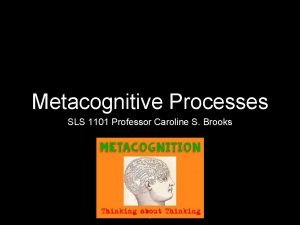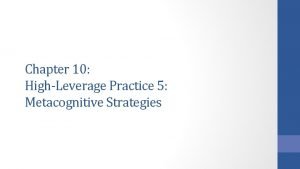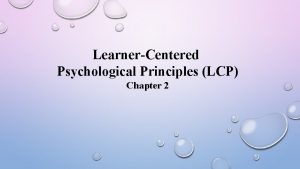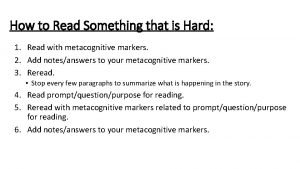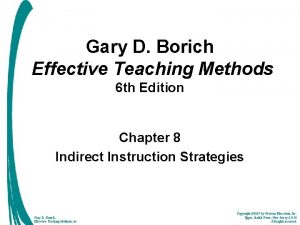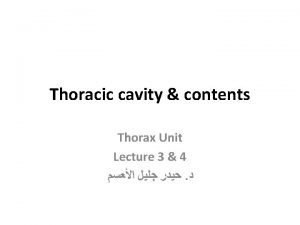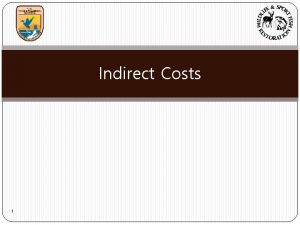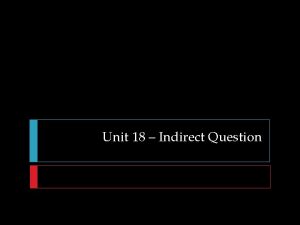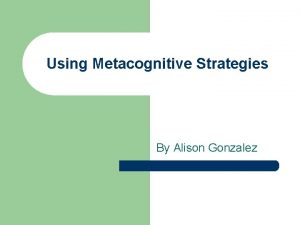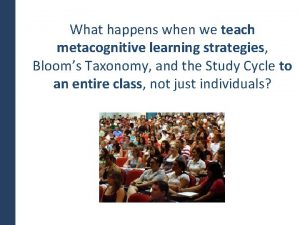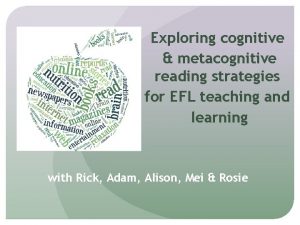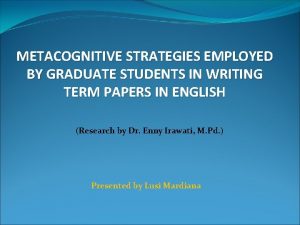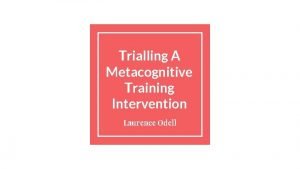Indirect Strategies Unit 2 Content Indirect Strategies METACOGNITIVE
































- Slides: 32

Indirect Strategies Unit 2

Content Indirect Strategies

METACOGNITIVE STRATEGIES 1. Assessing yourself 2. Setting goals and objectives 3. Planning 4. Seeking practice opportunities A

Chamot and O’Malley (1994) A B C D Planning strategies help you to learn to organize yourself for a learning task. Monitoring strategies help you check your comprehension in listening and reading and your production while speaking and writing. Evaluating strategies teach you how to assess your own performance on a task.

Task 1 Match the metacognitive strategy sets with the specific metacognitive strategies. A B Metacognitive Strategy Sets A. Centering your learning B. Arranging and planning your learning C D C. Evaluating your learning Specific Meta-cognitive Strategies (1) self-monitoring (2) finding about language learning (3) overviewing and linking with already known material (4) self-evaluating (5) paying attention (6) organizing (7) setting goals and objectives (8) seeking practice opportunities (9) delaying speech production to focus on listening (10) identifying a purpose of a language task (11) planning for a language task

Task 2 What are your strengths and weaknesses in learning English? A B My strengths in learning English My weaknesses in learning English C D 1. Assessing yourself

Task 3 To set long-term goals, first answer the following questions. A B C Why are you learning English? (check more than one) for good grades to enjoy English films because I want to study abroad because English is required for graduation for fun for a well-paid job for exams to make new friends Other(list)____ D 2. Setting goals and objectives

Task 3 A B C D Which skills are the most important to you? Given the purposes you have identified, decide which skills are the most important and how you need to spend your learning time. Indicate the importance of each knowledge and skill area (1 = least important, 5 = most important). Then indicate how important you want to become in each area (Low, medium, High). Area 1. Speaking 2. Listening 3. Reading 4. Writing 5. Pronunciation 6. Vocabulary 7. Grammar 8. Culture Importance (List 1 to 5) Desired proficiency (List Low, Medium, High) _________ _______________ _________ _______________ 2. Setting goals and objectives

Task 3 A B On the basis of your purposes, strengths and weaknesses, and priorities, what are your longterm goals for learning English for the next months or years? Make SMART goals (S = Specific, M = Measurable, A = Attainable, R = Realistic, T = Timely). Write down a date for each goal ― a time by which you expect to reach that goal. Setting such a date will enable you to check your progress toward meeting your goal. I would like to be able to do the following Goals Deadlines C D 2. Setting goals and objectives

Task 3 A B C D After you have set your long-term goals, set yourself some short-term objectives, too. These are your aims for the next few hours, days, or weeks. Again set a deadline for yourself. Check your progress. Objectives Deadlines Accomplished or not? Time of accomplishment (1) (2) (3) (4) (5) 2. Setting goals and objectives

A B The difference between setting goals and planning is that when you set goals and objectives your focus is on what you hope to achieve while when you plan your focus is on how to use your time well in order to achieve your aims. In college you have more time at your own disposal than when you were in high school and this means time management skills are all the more important. C D 3. Planning

Task 4 For each question, circle the number that best describes you. 1=Never 2=Seldom 3=Sometimes 4=Often 5=Always A 1. How often do you plan for English learning? 1 2 3 4 5 2. Do you put daily plans on paper? 1 2 3 4 5 B 3. Do you allow flexibility in your plans? 1 2 3 4 5 4. How often do you accomplish all you plan for a given day? 1 2 3 4 5 C 5. How often do you plan time for what matters most to you? 1 2 3 4 5 6. How often is your daily plan destroyed by urgent interruptions? 1 2 3 4 5 D • Add the circled numbers and you get your score. Write it here: ______ What does your score mean? Are you a good planner? Ask your teacher to find out. 3. Planning

What does the score mean? A B C D Task 4 6 -10: Terrible Planner. You should consider using new tools and processes to help you plan effectively. A great first step would be to take a time management course. 11 -15: Below average planner. You may already have a planning system, but using it more effectively will help to reduce the stress and lack of control you feel in your life. 16 -20: Average planner. Your planning system is working, but you can do better. You may need help focusing on priorities, dealing with urgent interruptions or writing your daily plan. 21 -25: Above-average planner. Your planning system is working well. Keep up the good work, with periodic reviews to be sure you’re planning around what matters most in your life. 26 -30: Excellent planner—or candidate for burnout? You have mastered planning and should experience the serenity that comes from taking charge of your life. But make sure you’re in control of your planning rather than letting it control you. 3. Planning

Task 4 A B C Here are five Steps to Successful Time Management 1) Set specific academic and personal goals. 2) Create a term calendar, recording major events. 3) Create a weekly schedule of your classes, labs, clubs, meetings, etc. 4) Decide on specific times to work on each course. 5) Make a to-do list for each day the night before or during breakfast D 3. Planning

Task 5 A B Make a schedule of your typical week, including classes, independent study, time for practicing English individually, time for practicing English with others, part-time job, volunteering work, sleeping, eating, and so on. Pay special attention to time available for learning English after class. Week by week, write down your plans for learning English. Morning Midday Afternoon Evening Monday C Tuesday D Thursday Wednesday Friday Saturday Sunday 3. Planning

Task 6 A B C D List all the opportunities that you can think of for practicing English. These can be either existing opportunities or opportunities that you might create. Be specific. Next to each listed opportunity indicate whether you are now taking advantage of it. If yes, mark √; if no, mark ×. Then work in pairs and have a discussion. 1) 2) 3) 4) 5) 6) 7) 8) 9) 10) Practice opportunities _________________________________ _________________________________ _________________________________ Taking advantage? __________ __________ __________ 4. Seeking practice opportunities

AFFECTIVE STRATEGIES 1. Lowering your anxiety 2. Encouraging yourself 3. Taking your emotional temperature B

Task 7 Match the affective strategy sets with the specific affective strategies. A B C D Affective Strategy Sets A. Lowering your anxiety B. Encouraging yourself C. Taking your emotional temperature Specific Affective Strategies (1) Discussing your feelings with someone (2) Writing a language learning diary (3) Using a checklist (4) Listening to your body (5) Rewarding yourself (6) Taking risks wisely (7) Making positive statements (8) Using laughter (9) Using music (10)Using progressive relaxation, deep breathing, or meditation

Task 8 Read each of the following statements and indicate whether you: Strongly agree = SA= 5 Agree = A = 4 Disagree = D = 2 Neither agree nor disagree = N = 3 Strongly disagree = SD = 1 A B C D 1. I worry a lot about making mistakes in my English class. 2. I only talk in class when I know I can get it right. 3. I think I am one of the worst students in my class. 4. I think I’m holding the rest of the class back. 5. I only talk in class if the teacher asks me something. 6. I’m always glad if the teacher doesn’t ask me to give an answer. 7. I’m afraid people will laugh at me when I get things wrong in class. 8. I hate role-play exercises when you can’t avoid talking with other students. 9. I always end up trembling if I have to talk in class. 10. I don’t usually know the answers to the questions the teacher asks. 11. When it’s my turn to answer a question I break out in a sweat. 12. I think my class is going too fast for me. SA 5 5 5 5 A 4 4 4 4 N 3 3 3 3 D 2 2 2 2 SD 1 1 1 1 5 4 3 2 1 5 5 4 4 3 3 2 2 1 1 1. Lowering your anxiety

Task 8 • Add the circled numbers and you get your score. Write it here: _____ • What does your score mean? Ask your teacher to find out. A B C D What does your score mean? 48 -60: the danger zone. There are two things you have to do: 1) talk to the teacher and explain how you feel in class; 2) learn to take more risks. 25 -47: most people fall into this category. Things for you to do: 1) learn to be more adventurous; 2) push yourself a bit harder; 3) ask the teacher questions, instead of waiting for him or her to ask you. 1. Lowering your anxiety

Task 9 Now list the NEGATIVE things you say to yourself. How do these statements make you feel about yourself as an English language learner? A B C D What NEGATIVE things do you say to yourself? 1. How does the statement make you feel? 2. 3. 4. 5. 2. Encouraging yourself

Task 9 A B How often do you say POSITIVE things to yourself? What do you say? How does what you say make you feel about yourself and about learning English? List all the positive things you say to yourself and describe how they make you feel. What POSITIVE things do you say to yourself? 1. How does the statement make you feel? 2. C 3. D 5. 4. 2. Encouraging yourself

Task 10 A B • List language tasks or events in which you have just been involved, for example, giving a presentation, writing a letter, holding a conversation, reading a poem etc. • Describe how you felt when you were involved in the tasks or events and how you are feeling now. • Try to explain why certain tasks or event triggered particular feelings. Language tasks or events How you felt then How you are feeling now C D 3. Taking your emotional temperature

Task 10 Here are some words and expressions you can use to describe your feelings. A B C happy unhappy confident proud ashamed unconfident afraid unafraid cautious risk-taking clear-thinking confused friendly unfriendly calm angry interested bored strong weak energetic tired shy outgoing critical accepting tolerant intolerant want to learn more want to give up peaceful anxious D 3. Taking your emotional temperature

SOCIAL STRATEGIES 1. Asking questions 2. Cooperating with others 3. Empathizing with others C

Task 11 Match the social strategy sets with the specific social strategies. A B c D Social Strategy Sets A. Asking questions Specific Social Strategies (1) (2) (3) B. Cooperating with others (4) (5) C. Empathizing with others (6) Developing cultural understanding Becoming aware of others’ thoughts and feelings Asking for clarification or verification Asking for correction Cooperating with proficient users of English Cooperating with peers

Task 12 A B c D Observe two classmates talk in English and note down the questions they asked. What is the purpose of each question? Write the corresponding number next to each question. 1 = Asking for clarification (when something is not understood) 2 = Asking for verification (when the speaker wants to check whether something is correct) 3 = Asking for correction 4 = Other Questions? Purposes? (1)____________________________ (2)____________________________ (3)____________________________ (4)____________________________ (5)____________________________ (6)____________________________ (7)____________________________ 1. Asking questions

Task 13 Work in pairs and discuss the following questions: A B c • • • Why do you think cooperative learning is important for language learners? Do you prefer cooperative learning or competitive learning? Why? Have you ever felt competitive in a language learning experience? If yes, what were the circumstances? What might have encouraged you to feel competitive? Was the experience pleasant or unpleasant? D 2. Cooperating with others

Task 12 A B c D Each of the following statements refers to how you feel about English and English speakers. Please indicate whether you: Strongly agree = SA = 5 Agree = A = 4 Disagree = D = 2 Neither agree nor disagree = N = 3 Strongly disagree = SD = 1 1. On the whole, I like English speakers a lot. 2. I enjoy talking with English speakers. 3. I think English speakers would respect me more for learning to speak their language. 4. It’s a mark of respect to learn other people’s language if you have to deal with them a lot. 5. I’m interested in American and British culture. 6. I feel at ease with English speakers. 7. I think English is a beautiful language. 8. I’d like to live for a while in a country where English is spoken. 9. Being able to speak English will let me help other people more than I can at the moment. 10. I don’t like talking to English speakers in English. SA 5 5 5 5 5 A 4 4 4 4 4 N 3 3 3 3 3 D 2 2 2 2 2 SD 1 1 1 1 1 3. Empathizing with others

Task 12 • A B c D Add the circled numbers and you get your score. What does your score mean? If you scored 40 points or more, you identify very strongly with English speakers. Work by yourself and answer the following questions. ü How much empathy do you have for others? ü Do you think you identify with others or not? ü How do you think this influences your ability to learn English? Provide specific examples. 3. Empathizing with others

SUMMARY D In this unit we have introduced three groups of indirect language learning strategies, namely, metacognitive strategies, affective strategies, and social strategies. We have also introduced the specific strategies in each group. Opportunities have been provided for you to learn about and to use some of these important strategies.

Bye~ THANKS HAVE A NICE DAY!
 What are metacognitive strategies
What are metacognitive strategies 5 metacognitive strategies
5 metacognitive strategies Metacognition cambridge
Metacognition cambridge Principle referring to motivational and affective factors
Principle referring to motivational and affective factors How did joby join the army
How did joby join the army Characteristics of esp
Characteristics of esp Dynamic content vs static content
Dynamic content vs static content Marzano reviewing content
Marzano reviewing content Unit 10, unit 10 review tests, unit 10 general test
Unit 10, unit 10 review tests, unit 10 general test Direct guidance examples
Direct guidance examples Indirect instruction
Indirect instruction Metode pembiayaan langsung (direct financing method)
Metode pembiayaan langsung (direct financing method) Right triangle trigonometry
Right triangle trigonometry Si vs english units
Si vs english units Unit 1 test algebra 2 answers
Unit 1 test algebra 2 answers Contoh soal perhitungan unit cost rumah sakit
Contoh soal perhitungan unit cost rumah sakit Unit process and unit operation
Unit process and unit operation Unit operation and unit process
Unit operation and unit process Setiap unit akuntansi dianggap sebagai unit yang mandiri
Setiap unit akuntansi dianggap sebagai unit yang mandiri Content objective examples
Content objective examples Etymology
Etymology Open word classes
Open word classes What are content buckets
What are content buckets Introduction to dynamic web content
Introduction to dynamic web content Academic vocabulary toolkit
Academic vocabulary toolkit Content validity
Content validity Face validity definition
Face validity definition Forms of validity
Forms of validity Mobile user-generated content
Mobile user-generated content Thorax cavity
Thorax cavity Web content managment
Web content managment Cognition mse
Cognition mse What does the subscapular artery supply
What does the subscapular artery supply
